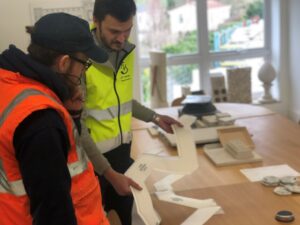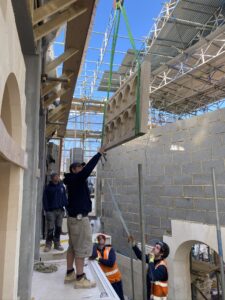For the Directors’ Cut this week, we get right to the heart of AFJ project managers’ motivation and outlook for stonemasonry projects in an interview with Ken Jones.
Ken is a Chartered Engineer by professional background, joining AFJ in 2015, bringing his experience and outlook as a design engineer and technical team leader to the A F Jones Stone business. His view on holistic stonemasonry is a touchstone for our project management outlook and ethos.
Q: When a new commission comes through the door at AF Jones Stonemasons, how would you characterise your initial views of the coming project?
Starting each project is an exciting time; it’s an opportunity to create a new piece of historic fabric that will be cherished by our ancestors perhaps. Or to build spaces and buildings that inspire and lift the spirit. Or even at its simplest, to be elegantly functional, yet at the same time natural and beautiful.

Hand drawn details on a building project design
Stonemasonry is ‘architectural’ at its core, yet also very much an ‘engineering’ discipline alongside ‘construction’, as well as holding a strong and traditional ‘craftmanship’ element at individual component level. It bridges many disciplines, encouraging creativity & inventiveness whilst demanding an array of design skills and problem solving.
At AF Jones, this means we dream big and deliver award winning projects – overcoming complex challenges is inherent to our DNA as a business.
Yet we remain both personable and the best partner through the project process – and this is an important aspect of who we are and how we work.
The wonder of stone is partly within the myriad options and variables available so for a new project, the greatest fulfilment derives from giving good advice, helping clients and designers to achieve their vision, but within their budget expectations or any other constraint.
It is often positioned purely as a ‘luxury’ material – yet selected properly, detailed correctly and built with care – I sincerely believe natural stone is one of the best investments anyone can make in their own legacy and to the built environment generally.
Q: What are the five key phases to a project? As a stonemason with a structural engineering outlook, how do you ensure that a holistic approach is bound into these?
- Inception (listening & thinking) is the first stage.

AF Jones Stonemasonry Design team and Production team scrutinising templates
It’s important to keep an open mind at outset, starting with listening and understanding the fundamental drivers. We need to understand the opportunities and what are the constraints too – stone options; budgets; site logistics; design considerations all matter here.
There’s always some ‘obvious’ solutions but it’s good to spend time exploring ideas and not close-down options too early. This is an opportunity to be creative – to offer a variety of solutions and see where the collaborative decisions lead.
- Design development/Technical phase.
This is when we start to answer the difficult questions. What are the tricky interfaces? How will it be built? Where are the key risks? What surveys are needed and when? What tolerances are important? How will water be managed? Which stone detailing arrangement will work best and is that influenced by the stone selection?
The questions are endless and interlinked and this phase is absolutely key to ‘finding the right path’ for the project, as near to the outset as possible.
The questions (and the answers), will differ radically according to which sector the project sits in; be it Architectural (new build), Heritage, or a Natural Stone Interior. Each of these are essentially completely separate disciplines, albeit linked by the commonality inherent to the nature of the base material.

The complex finishes in Natural Stone possible with a strong team from inception to completion are limitless
- Planning phase
The key to successful projects, after those critical early decisions, is in managing the process smoothly.
Allowing enough time is absolutely vital; partly because each-and-every stone has a journey involving multiple, careful steps. It’s a bit like ‘snakes-and-ladders’. If you hit a snag, you can quite easily end up right back at the start point, often through no fault of your own.
Therefore, managing the risks and processes pro-actively and super-carefully is the only way to make the complex ‘appear’ simple. This is what we aim to do at AF Jones and most often achieve.
Allowing enough time for design iterations and approvals is also essential, as is understanding quarry output related to volume projects. Then there’s organising sequence and ‘flow’ at site; labelling and palletisation and ensuring transport and site logistics and so on. From the expert comes foresight – and foresight avoids risk and costs for all stakeholders.
- Production Phase.
Production is never a one-trick pony!

The AF Jones Stonemasonry site team installing a carved screen by crane at a complex build
The challenge may lie in the detail, or the sheer volume, or perhaps in the accuracy required for tight jointing. Equally it might lie in the unit sizes, or an applied finish; or in the complex geometry, or the hardness of the selected stone.
Compound these potential challenges with variability in the blocks (range), and the finesse to achieve crisp edges and fine arises, and the packing for transport and site sequence, there is much to consider at every turn. We work hard to make sure time-pressure is not then layered on top of all these potential challenges as well!
A Holistic Stonemasonry Team
I am still in awe of the skill, concentration, patience and brilliance of our production masons. It is extremely demanding, and it also requires truly ‘joined up’ teamwork – with the proverbial baton passing from designer, to CNC programmer, to machinist team, to banker mason team, to the packing / storage and delivery team.
Each skill is rare, takes years of training, relies on plant and equipment that has to cope with severe environmental wear and demands, and if any of the links in this chain is missing, it would create true difficulty (or cost, or time). Communication has to pass through the chain, and every piece of information has to be verified, often through 3D modelling and detailed site laser survey.
Do you have a project you want to make a reality? Let’s have a conversation about it: info@afjones.co.uk tel: 01491 835032
Frequently Asked Questions
- What makes a holistic approach to stonemasonry essential for high-end architecture projects? Understanding the comprehensive integration of design, material selection, and craftsmanship in stonemasonry ensures that every aspect of the project is aligned with the client’s vision and the structural integrity of the building, resulting in a seamless and high-quality finish.
- How do the unique properties of natural stone influence the design and execution of architectural projects? Natural stone’s durability, aesthetic versatility, and unique textural qualities make it a preferred material for luxury architecture, influencing everything from structural decisions to fine detailing to meet both functional and aesthetic criteria.
- What are the key phases of a stonemasonry project and how do they ensure project success? The key phases—Inception, Design Development, Planning, Production, and Completion—involve rigorous planning, creative problem-solving, and meticulous execution, ensuring that each project is delivered to the highest standards of quality and precision.
- How does AF Jones Stonemasons manage the complexities of integrating traditional craftsmanship with modern engineering in their projects? By leveraging advanced technologies like 3D modelling and CNC machinery alongside traditional stonemasonry techniques, AF Jones bridges the gap between old and new, ensuring precision and efficiency while maintaining the artistry of stonemasonry.
- Why should architects and developers choose AF Jones Stonemasons for their high-end projects? AF Jones is renowned for its award-winning approach to stonemasonry, combining deep expertise in natural stone, innovative design solutions, and a commitment to craftsmanship, making us a leader in producing enduring and aesthetically superior architectural works.
